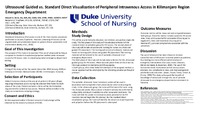Ultrasound guided vs. standard direct visualization of peripheral intravenous access in Kilimanjaro Region emergency department
View File(s)
- Author(s)
- Details
-
Edward C. Stene, BA, BSN, RN, CCRN, CEN, CFRN, PHRN, CCEMTP, EMTP (1); Benjamin A. Smallheer, PhD, RN, ACNP-BC, FNP-BC, CCRN, CNE (1); Elias J. Jaffa, MD (2) - (1) School of Nursing, Duke University, Durham, NC, USA; (2) School of Medicine, Duke University, Durham, NC, USA
- Sigma Affiliation
- Pi at-Large
- Contributor Affiliation(s)
- Duke University, Durham, North Carolina, USA
Visitor Statistics
Visits vs Downloads
Visitors - World Map
Top Visiting Countries
| Country | Visits |
|---|
Top Visiting Cities
| City | Visits |
|---|
Visits (last 6 months)
Downloads (last 6 months)
Popular Works for Stene, Edward C. by View
| Title | Page Views |
|---|
Popular Works for Stene, Edward C. by Download
| Title | Downloads |
|---|
View Citations
Citations
The use of ultrasound is becoming more portable and affordable for healthcare providers. However, there is scant literature on ultrasound use for PIV access outside of developed countries.
45th Biennial Convention 2019 Theme: Connect. Collaborate. Catalyze.
| Type | Poster |
| Acquisition | Proxy-submission |
| Review Type | None: Event Material, Invited Presentation |
| Format | Text-based Document |
| Evidence Level | N/A |
| Research Approach | N/A |
| Keywords | Emergency Department; Peripheral Intravenous; Peripheral Intravenous Access; Portable Ultrasound; PIV |
| Name | 45th Biennial Convention |
| Host | Sigma Theta Tau International |
| Location | Washington, DC, USA |
| Date | 2019 |
All rights reserved by the author(s) and/or publisher(s) listed in this item record unless relinquished in whole or part by a rights notation or a Creative Commons License present in this item record.
All permission requests should be directed accordingly and not to the Sigma Repository.
All submitting authors or publishers have affirmed that when using material in their work where they do not own copyright, they have obtained permission of the copyright holder prior to submission and the rights holder has been acknowledged as necessary.
Related items
Showing items related by title, author, creator and subjects.
-
Outcomes of a simplified ultrasound-guided intravenous program for emergency nurses
Feinsmith, Sarah; Huebinger, Ryan; Pitts, Michael; Baran, Emily; Ketterer, Andrew; Haas, Sheila (2017-12-05)Purpose: The purpose of this study was to produce an applicable and economical model of Ultrasound-Guided Intravenous access (USGIV) training and competency for emergency nurses and examine emergency nurse skill acquisition ... -
Using ultrasound guided PIV insertion in the pediatric population
Steege, Shana L.; Stout, Jacqueline S.; Rider, Carla ElaineIntravenous therapy is a frequently used medical intervention. There is evidence that ultrasound guided PIV (USGPIV) placement in children reduces the number of attempts to successful cannulation. This study implemented ... -
Using ultrasound-guided peripheral intravenous access in difficult intravenous access patients
Hampton, DianaInserting a peripheral intravenous catheter (PIVC) can be challenging on the first attempt. At the project site there was no systematic process to impact failed first-attempt success for PIVC access, so an evidence-based ... -
Developing a culture of direct bedding in a freestanding ED
Novakovich, Elisabeth; Woodman, Judy; Woodman, Charles EdwardSession B presented Thursday, September 27, 11:30 am-12:30 pm Purpose: Emergency Department overcrowding is a serious problem that has a strong correlation with patient satisfaction.Wait times and overcrowding in Emergency ... -
Accelerating care using a standardized protocol for psychiatric emergency patients
Winokur, Elizabeth J.; Loucks, Jeannine (2017-12-05)Session D presented Friday, September 15, 2017 Purpose: Behavioral health (BH) complaints are a component in one out of every eight emergency department visits. With the closing of many inpatient psychiatric beds, ...





